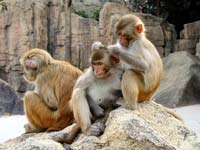
![]() Say the word 'statistician' and most people might think of an intelligent but reclusive person, probably working in a darkened room and almost certainly wearing glasses. But a new study shows that a monkey in front of a monitor can make a reasonably good statistician too.
Say the word 'statistician' and most people might think of an intelligent but reclusive person, probably working in a darkened room and almost certainly wearing glasses. But a new study shows that a monkey in front of a monitor can make a reasonably good statistician too.
 Tianming Yang and Michael Shadlen from the University of Washington found that rhesus macaques can perform simple statistical calculations, and even watched their neurons doing it. Psychologists often train animals to learn simple tasks, where the right choice earns them a reward and the wrong one leaves them empty-handed or punished. But real life, of course, is not like that.
Tianming Yang and Michael Shadlen from the University of Washington found that rhesus macaques can perform simple statistical calculations, and even watched their neurons doing it. Psychologists often train animals to learn simple tasks, where the right choice earns them a reward and the wrong one leaves them empty-handed or punished. But real life, of course, is not like that.
Mostly, there are risks and probabilities in lieu of guarantees or right answers. Animals must weigh up the available information, often from multiple sources, and decide on the course of action most likely to work out in their favour.
Yang and Shadlen tested this decision-making ability in two rhesus macaques using a variation of the well-known weather prediction task used to test human volunteers. In the human version, people are shown a series of cards that represent various probabilities of good or bad weather. After some training, they are shown combinations and asked to predict the likely weather from these.
The monkeys had a slightly simpler task - they had to look at either a green or a red target. If they picked the right one (which changed from trial to trial), they were rewarded with a tasty drink. To help the monkeys choose, Yang and Shadlen showed them a series of shapes that represented the probability that the rewarding target was red or green.
For example, a square strongly indicated that the red target was the rewarding one, while a triangle strongly favoured the green one, and an hourglass only slightly favoured the green. The monkeys were shown four shapes out of a possible ten, and to get the right answer, they had to add up the probabilities indicated by these shapes.
 And that is exactly what they did. They learned to base their decisions on the combined probabilities of the four shapes, and chose the appropriate target. It did, however, take them a while to learn (or two months of training with over 130,000 trials to be exact). Any statisticians reading this don't need to fear about being replaced by monkeys any time soon.
And that is exactly what they did. They learned to base their decisions on the combined probabilities of the four shapes, and chose the appropriate target. It did, however, take them a while to learn (or two months of training with over 130,000 trials to be exact). Any statisticians reading this don't need to fear about being replaced by monkeys any time soon.
They weighed up the strength of the evidence too. When the shapes strongly suggested one colour, the monkeys almost always went with that colour. When the summed probability lay between the two extremes, they chose either target but still favoured the one indicated by the shapes.
With 715 different combinations of shapes, the experiment's design makes it highly unlikely that the monkeys simply memorised the 'answers' for different mixes. And because the shapes only dealt in probabilities, it was still possible to choose the wrong target, even if the monkey strictly adhered to the shapes' advice. They were clearly reasoning with probabilities, and in pretty subtle ways.
For their next trick, Yang and Shadlen visualised this reasoning directly by looking at 64 neurons in the monkeys' lateral intraparietal area (LIP). This part of the brain is responsible for several higher functions like mathematical skills. Other studies have found that the LIP collects data from the visual cortex, and helps to process what the monkey sees.
When the monkeys saw a shape, the activity of their LIP neurons was proportional to the probability indicated by that shape. As the four shapes were shown in sequence, the neurons altered their rate of firing to account for the new information. As the evidence was building up, the monkeys were busy doing sums in their heads. Yang and Shadlen were seeing arithmetic in action.
Of course, monkeys are living things and not fuzzy calculators, and they were not equally good at statistical reasoning. One was clearly better than the other, and Yang and Shadlen put this down to differences in their neurons.
Each neuron varies slightly in its typical firing rate, and summed together, these variations can lead to biases in how the monkeys deal with calculations. This explains why the monkeys sometimes did different things when shown the same combination of shapes.
Their confusion was particularly apparent when the shapes gave no strong inclination to pick one target or another. We can certainly relate to that - after all, it's certainly harder to make a decision, when neither option seems particularly better than the other.
Yang and Shadlen believe that human brains use similar methods to make decisions. Cues about probabilities are funnelled into the brain's control centres (like the LIP), which act like calculators powered by the firing of neurons.
Reference: Yang & Shadlen. 2007. Probabilistic reasoning by neurons. Nature (doi:10.1038/nature05852)

Has anyone ever tried to teach monkeys to play poker?
The scientific (& velvet painting) possibilities are endless...
This is so interesting!
Anna :)
A fascinating piece of research, thanks for reposting it Ed:-)